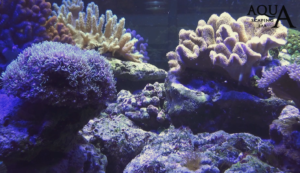14 Apr LIVE REEF ROCKS for saltwater aquarium, importance and usefulness
 Live rocks are used for two basic and fundamental reasons: Structural and aesthetic, and biological filtration. Live rocks are fragments of limestone material of coral origin that are detached from the reef and exported for sale on the aquarium market. Will play a aesthetic role giving a very natural look to the aquarium, and a structural role, being the basis on which you’ll position live corals, crustaceans and fish. after some months, will tend to “cemented” thanks to the work of the calcareous algae. Unlike freshwater aquarium, that has how main biological filter, the porous material inside the filter, in reef aquarium we rely on these fantastic rocks because they have two main properties:
Live rocks are used for two basic and fundamental reasons: Structural and aesthetic, and biological filtration. Live rocks are fragments of limestone material of coral origin that are detached from the reef and exported for sale on the aquarium market. Will play a aesthetic role giving a very natural look to the aquarium, and a structural role, being the basis on which you’ll position live corals, crustaceans and fish. after some months, will tend to “cemented” thanks to the work of the calcareous algae. Unlike freshwater aquarium, that has how main biological filter, the porous material inside the filter, in reef aquarium we rely on these fantastic rocks because they have two main properties:
1 – A high porosity and therefore an ease colonization of the Nitrosomonas and Nitrobacter bacteria that perform the transformation process of the Ammonium to Nitrite and then in Nitrate, (inside we have anaerobic bacteria, in exterior part, aerobic bacteria) then lowering chemically all the waste substances of the animals and that would be dangerous for their health.

2 – Each rock is populated by hundreds of protozoa micro-invertebrates and those contributes significantly to the aquarium ecosystem biodiversity and consequently to its stability. The encrusting fauna consists mostly of tiny worms, crustaceans and molluscs, that feeding contribute to the removal of debris and cancellation of some pollutants dissolved in water. Moreover, the rocks release continuously larvae of organisms that enrich the Plankton of the tank, an important source of live food for invertebrates. Creating a real food chain that could not be created artificially by purchasing microorganisms from the merchants but that with the maturation occurred in the sea, imported directly into our tank.
Generally, in the market there are different types of live rock from Indonesian seas, Pacific Ocean, Atlantic and Mediterranean, and can be classified into various types:
– Basic rocks: have a lower cost, and we can positioned under of live rock, are very porous limestone, jagged still quite “virgin” that, with time, will be colonized by micro organisms introduced into the tank .
– Rocks with vegetation: colonized by one or more species of algae.
– Rocks with zoanthids: They come mainly from the Atlantic and Pacific Oceans, they are collected in transparent waters and are colonized by one or more species of zoanthids.
– Rocks with invertebrates such Discosoma: Hailing from the Pacific and covered by disc-shaped invertebrates, of various diameters of green, blue, orange or pink.
How can understand if a live rock is of good quality or not? A living rock of excellent quality has a porous, spongy structure with numerous holes and cavities. A not good rocks is often covered by a thin slurry and gives off a strong smell of decomposition by the death of micro-organisms.

How can I prepare a rock before release into the aquarium? Before putting in the tank it is better to observe them, wash in salt water to avoid an ammonia peak impact. During this operation it is better to have a container of aquarium water in case it should appear some surprise guest, should then capture it and separate it. You must be careful to these guests for example crabs, initially very nice and a few millimeters but in a few months can turn into predators. Attention also to mantis shrimps: often found in the Indonesian rocks and once inadvertently placed in the tank will be almost impossible to catch them. Another unwelcome presence is the annelids worms, especially those fitted with bristles and hairs, which can reach considerable size and even feed on corals and molluscs.

The ratio in a tank? With fish and corals should be indicatively from a minimum of 1 kg of rock per 10 liters of water, to a maximum of 1 kg per 5 liters. Remember that the cost of live rock, especially if good quality, will be unique but high and unfortunately necessary: for a 500 liter aquarium the amount will be between 1,000 and 2,000 euro.



 English
English Italiano
Italiano